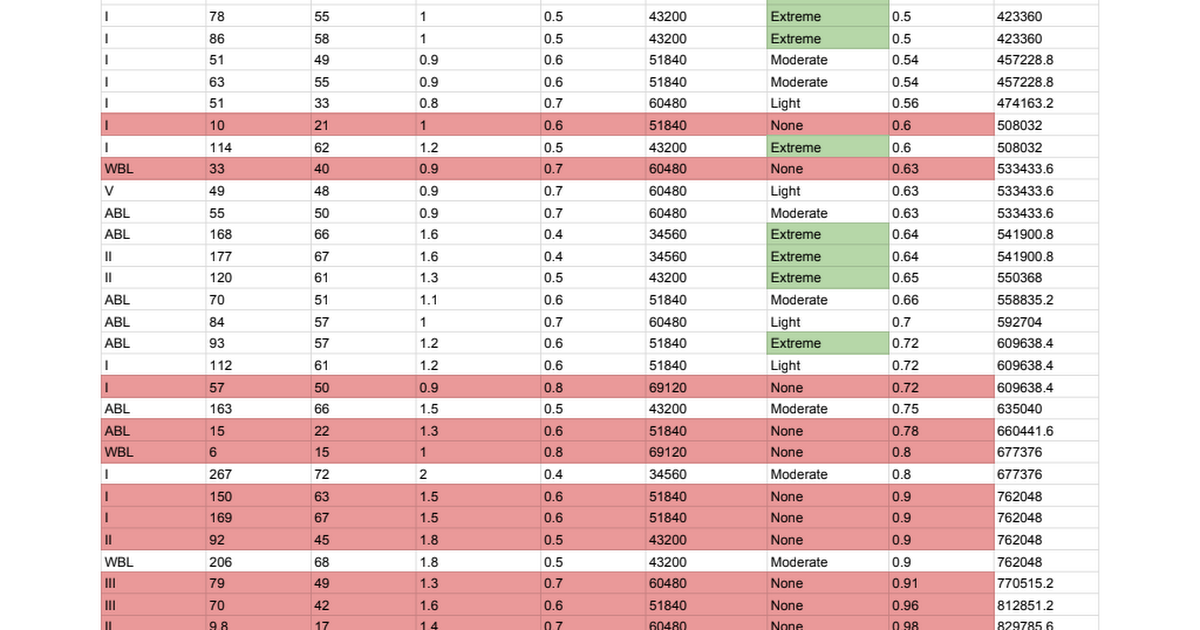You are using an out of date browser. It may not display this or other websites correctly.
You should upgrade or use an alternative browser.
You should upgrade or use an alternative browser.
Elite Observatory - Search your journal for potentially interesting objects, or notify you of new ones on the fly while exploring!
- Thread starter Vithigar
- Start date
The density may be broadly similar between various GGs of same type (not even sure about that), but between different types it varies greatly.Surface gravity being a function of mass and radius, with mass being a function of density and radius and the density of gas giants being broadly similar, surface gravity is, to a good approximation, a function of radius so it shouldn't make a lot of difference which one you use.
One of the fastest is listed at about 0.2 seconds (Synuefe IK-C d14-69 2). Yikes.
Bad EDSM data updated by my scan - this close to the bubble probably manually entered to EDDB yonks ago. It's actually 0.2D.

{
"timestamp": "2019-12-21T01:05:38Z",
"event": "Scan",
"ScanType": "Detailed",
"BodyName": "Synuefe IK-C d14-69 2",
"BodyID": 10,
"Parents": [
{
"Star": 0
}
],
"StarSystem": "Synuefe IK-C d14-69",
"SystemAddress": 2381366413691,
"DistanceFromArrivalLS": 2814.285889,
"TidalLock": false,
"TerraformState": "",
"PlanetClass": "Sudarsky class III gas giant",
"Atmosphere": "",
"AtmosphereComposition": [
{
"Name": "Hydrogen",
"Percent": 73.820122
},
{
"Name": "Helium",
"Percent": 26.179886
}
],
"Volcanism": "",
"MassEM": 885.603455,
"Radius": 77192400.0,
"SurfaceGravity": 59.237892,
"SurfaceTemperature": 283.702942,
"SurfacePressure": 0.0,
"Landable": false,
"SemiMajorAxis": 843702927360.0,
"Eccentricity": 2E-06,
"OrbitalInclination": 1.067743,
"Periapsis": 155.45137,
"OrbitalPeriod": 380080992.0,
"RotationPeriod": 20438.089844,
"AxialTilt": -3.090778,
"Rings": [
{
"Name": "Synuefe IK-C d14-69 2 A Ring",
"RingClass": "eRingClass_MetalRich",
"MassMT": 246170000000.0,
"InnerRad": 146960000.0,
"OuterRad": 171560000.0
},
{
"Name": "Synuefe IK-C d14-69 2 B Ring",
"RingClass": "eRingClass_MetalRich",
"MassMT": 2586500000000.0,
"InnerRad": 171660000.0,
"OuterRad": 334320000.0
}
],
"ReserveLevel": "PristineResources",
"WasDiscovered": true,
"WasMapped": false
}
"timestamp": "2019-12-21T01:05:38Z",
"event": "Scan",
"ScanType": "Detailed",
"BodyName": "Synuefe IK-C d14-69 2",
"BodyID": 10,
"Parents": [
{
"Star": 0
}
],
"StarSystem": "Synuefe IK-C d14-69",
"SystemAddress": 2381366413691,
"DistanceFromArrivalLS": 2814.285889,
"TidalLock": false,
"TerraformState": "",
"PlanetClass": "Sudarsky class III gas giant",
"Atmosphere": "",
"AtmosphereComposition": [
{
"Name": "Hydrogen",
"Percent": 73.820122
},
{
"Name": "Helium",
"Percent": 26.179886
}
],
"Volcanism": "",
"MassEM": 885.603455,
"Radius": 77192400.0,
"SurfaceGravity": 59.237892,
"SurfaceTemperature": 283.702942,
"SurfacePressure": 0.0,
"Landable": false,
"SemiMajorAxis": 843702927360.0,
"Eccentricity": 2E-06,
"OrbitalInclination": 1.067743,
"Periapsis": 155.45137,
"OrbitalPeriod": 380080992.0,
"RotationPeriod": 20438.089844,
"AxialTilt": -3.090778,
"Rings": [
{
"Name": "Synuefe IK-C d14-69 2 A Ring",
"RingClass": "eRingClass_MetalRich",
"MassMT": 246170000000.0,
"InnerRad": 146960000.0,
"OuterRad": 171560000.0
},
{
"Name": "Synuefe IK-C d14-69 2 B Ring",
"RingClass": "eRingClass_MetalRich",
"MassMT": 2586500000000.0,
"InnerRad": 171660000.0,
"OuterRad": 334320000.0
}
],
"ReserveLevel": "PristineResources",
"WasDiscovered": true,
"WasMapped": false
}
I used Observatory to revisit all the GGwABL's I've been to and came up with the data below. Of course, the "degrees of oblation" is subjective, but not hard to be consistent with. I hope someone more math-y than me can get somewhere with it. I'll get to the other types at some point.

 docs.google.com
docs.google.com
EDIT: Added a bunch of Class I's, all the V's I have on record, and several WBL's. The data includes that which @Zieman provided in the dedicated thread, with thanks.
Oblated Gas Giants
EDIT: Added a bunch of Class I's, all the V's I have on record, and several WBL's. The data includes that which @Zieman provided in the dedicated thread, with thanks.
Last edited:
As I'm victim of the bug that geological and biological signals not showing up immidiatly, is there a way to get informed when there are biological signals on a planet?
Bad EDSM data updated by my scan - this close to the bubble probably manually entered to EDDB yonks ago. It's actually 0.2D.
Excellent! I'll have to check on it in a few days, and see if the update it propagates through to my side.
Attach filesgeological and biological signals not showing up immidiatly
In this particular case, after I honked, there was a signal near the asteroid signal area. When I scanned it, I got a Notable Stellar Phenomenon target. I didn't know what it was until I flew out and dropped out of super-cruise in the target area.
I used Observatory to revisit all the GGwABL's I've been to and came up with the data below. Of course, the "degrees of oblation" is subjective, but not hard to be consistent with. I hope someone more math-y than me can get somewhere with it. I'll get to the other types at some point.
There does not appear to be an obvious correlation between the variables of mass, radius, rotational period, and degree of oblateness. I think we're missing something. An interesting data point would be how close these bodies are to their parent.
Trying to come up with a criteria for squishy GG's. I've collected data on six I've come across recently, and it looks like if it has a radius of less than 70,000km and a Rotational Period of less than .8 days, it will likely be squishy. Can anyone confirm this?
...
Came across this one yesterday. Squishy enough for you?
EDSM - Elite Dangerous Star Map
The Galactic Positioning System of Elite: Dangerous at your service.
I just added a RPxG column, and sorted the rows by the results. The odds are very high that when the product is less than 1.6 it will be a squishy. Only seven of the 44 of or under that value are "None," (1 in 6, or 16%) and the first occurs at #22, making the entire first 50% squishy. All of them with a value of over 1.6 are "None." Furthermore, 13 of the 16 (81%) "Extreme" examples have a value of .5 or less. I.e., the two clear fall-off points are .5 and 1.6.There does not appear to be an obvious correlation between the variables of mass, radius, rotational period, and degree of oblateness. I think we're missing something. An interesting data point would be how close these bodies are to their parent.
Oblated Gas Giants
EDIT: Added columns for RP (s) and G*RP (s), for a squishy criteria range of -6220-138240, accounting for negative RP's. So the criteria range would be -138240-138240, assuming that values between 0-6220 would indeed be squishy.
I'll poke around a bit this evening with the class II-IV's I have on record and see if they upset anything, but with really extreme examples of tiny I's and big V's I can't imagine they will. I suppose it's possible they may shed more light on the "None" 7, which I can make no sense of ATM.
EDIT sommore: Adding and sorting by a RP(d)/G column exclusively groups 4 of the 7 "None" entries from .35 to .46, with two at exactly .40. This is an extremely narrow range among a group that runs from .0086 to 20. If that ratio holds true and we don't figure out the others, that reduces the outliers to three in 40, 1 in 13, or 8%.
Last edited:
Came across this one yesterday. Squishy enough for you?
Perfectly "Extreme" squishy, as it happens, with an RP*G of .5! Thanks!
Edited to reflect post below, removing RP/G criteria.
XML:
<Criteria Comparator="And">
<Criteria Comparator="Equal" Value="1">
<Operation Operator="None">
<FirstValue Type="EventData">PlanetClass:gas giant with ammonia based life</FirstValue> [One criteria for each GG type]
</Operation>
</Criteria>
<Criteria Comparator="Between" LowerValue="-140000" UpperValue="140000">
<Operation Operator="Multiply">
<FirstValue Type="EventData">SurfaceGravity</FirstValue>
<SecondValue Type="EventData">RotationPeriod</SecondValue>
</Operation>
</Criteria>
<Description>Ammonia Life Squishy</Description>
<Detail>
<Item>DistanceFromArrivalLS</Item>
</Detail>
</Criteria>
Last edited:
I just added a RPxG column, and sorted the rows by the results. The odds are very high that when the product is less than 1.6 it will be a squishy. Only seven of the 44 of or under that value are "None," (1 in 6, or 16%) and the first occurs at #22, making the entire first 50% squishy. All of them with a value of over 1.6 are "None." Furthermore, 13 of the 16 (81%) "Extreme" examples have a value of .5 or less. I.e., the two clear fall-off points are .5 and 1.6.
I did a similar check. The none values throw off the rest of the correlation. If there is a trend there, it has a significant random component.
I did a similar check. The none values throw off the rest of the correlation. If there is a trend there, it has a significant random component.
Still, I'll take the odds for photographic discovery purposes, especially if the other classes bear them out. And especially considering the possibilities for multiple criteria; nested/close moons in orbit, etc. I have to think the none values are mathematically related somehow; again hoping the other classes will shed more light on that.
"Close orbit relative to parent body size"

https://www.edsm.net/en/system/bodies/id/46899592/name/Bloo+Bloae+UD-W+c4-7 , body 8 a a
Oh, and btw. - I think my computer pronounces "body 5 g" as "body 5 grams"

https://www.edsm.net/en/system/bodies/id/46899592/name/Bloo+Bloae+UD-W+c4-7 , body 8 a a
Oh, and btw. - I think my computer pronounces "body 5 g" as "body 5 grams"
Oh, and btw. - I think my computer pronounces "body 5 g" as "body 5 grams"
Same for me, but I think it's funny

